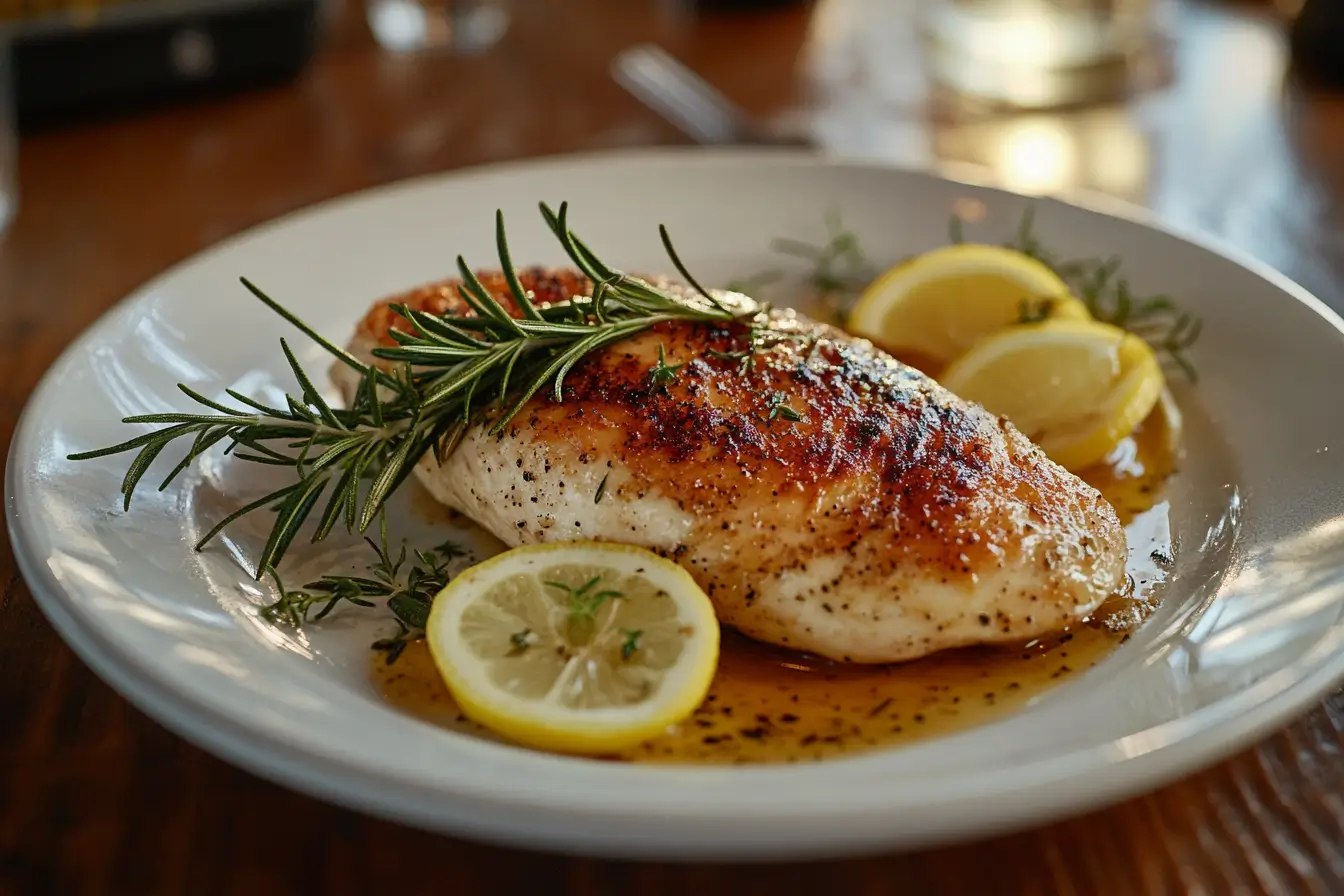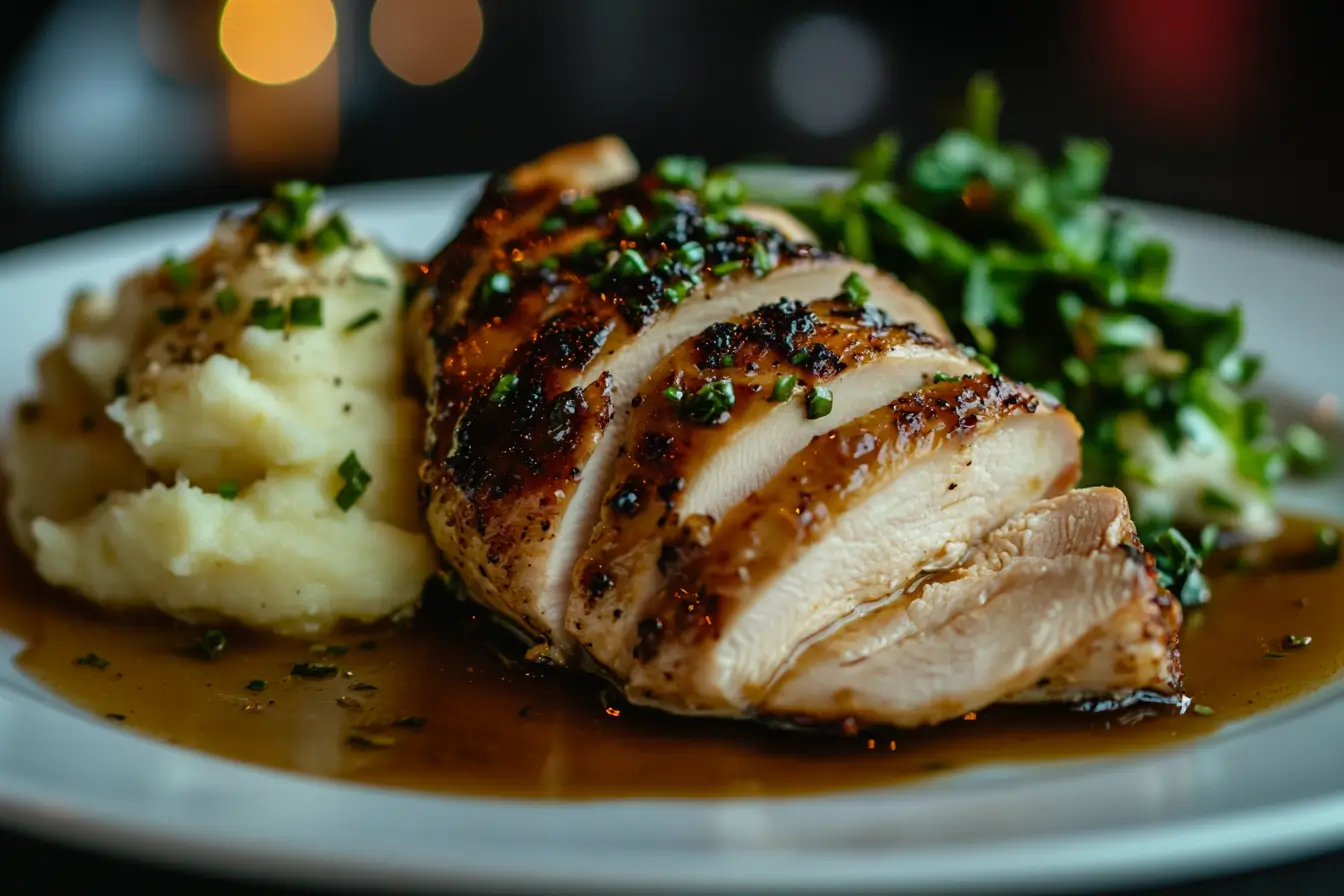Chicken breasts are a staple in many households. They’re lean, versatile, and high in protein. However, cooking juicy chicken breasts can be challenging, as the very qualities that make them healthy can also make them prone to dryness—especially if you’re not careful. Overcooking and failing to properly prepare the meat can result in a lack of moisture and flavor.
In this guide, we’ll explore a range of techniques to help you consistently achieve moist, tender chicken breasts. We’ll delve into the science behind why chicken can become dry, discuss the importance of brining and marinating, and break down various cooking methods. You’ll also find actionable tips for using a meat thermometer, prepping your chicken for the grill or oven, and avoiding common pitfalls. By following these steps, you’ll discover how easy it is to create flavorful, juicy chicken breasts that become the highlight of any meal.
Understanding Chicken Breasts
Before diving into the cooking process, it’s important to understand the basics of chicken breasts—what they are, why they tend to dry out, and how to select high-quality options at the grocery store.
2.1 Selecting Quality Chicken Breasts
- Look for Freshness: Fresh chicken should appear pinkish with minimal discoloration. Avoid packages with significant signs of bruising or yellowish fat.
- Check the Packaging: Ensure the packaging is intact, with no leakage. If the chicken is vacuum-sealed, look for any bulges or tears that could indicate spoilage.
- Pay Attention to Labels: Organic, free-range, or air-chilled chicken often boasts better texture and flavor, though these can be more expensive. If you can, opt for reputable brands or local farms.
2.2 Anatomy of a Chicken Breast
A chicken breast is made up of white muscle fibers, which are lower in fat compared to dark meat like thighs or drumsticks. These white fibers contain less connective tissue and fat, making them leaner and more susceptible to drying out.
2.3 Why Chicken Breasts Often Dry Out
- Low Fat Content: Since chicken breasts are low in fat, there’s less natural moisture. Cooking too long or at excessively high temperatures dehydrates the meat faster than fattier cuts.
- Muscle Structure: The protein strands in white meat tighten up and expel moisture quickly when exposed to high heat.
- Overcooking: One of the most common errors is simply leaving the chicken on the stove, grill, or in the oven for too long, causing a rubbery or stringy texture.
By understanding these factors, you’ll be better equipped to choose the right cooking method and practices to keep your chicken breasts juicy, tender, and flavorful.
2.4 Nutrition Facts (Per 100g of Cooked Chicken Breast)
| Nutrient | Amount |
|---|---|
| Calories | 165 kcal |
| Protein | 31g |
| Fat | 3.6g |
| Saturated Fat | 1g |
| Cholesterol | 85mg |
| Sodium | 74mg |
| Carbohydrates | 0g |
This nutritional profile highlights why chicken breasts are a favorite for those seeking a lean and protein-packed option.
Preparation Techniques
To set yourself up for success, you need to prepare your chicken breasts properly before they ever touch a pan, grill, or oven. Proper preparation methods—like brining, marinating, and pounding—can dramatically improve both flavor and texture.
3.1 Brining for Enhanced Moisture
What is Brining?
Brining involves soaking the chicken in a saltwater solution to help the meat retain moisture during cooking. Over time, the salt solution works its way into the muscle fibers, helping them stay plump and juicy.
Wet Brine vs. Dry Brine
- Wet Brine: A wet brine involves dissolving salt (and often sugar) in water. You can also add aromatics like bay leaves, peppercorns, or garlic. Submerge the chicken breasts in this solution for at least 30 minutes—longer if possible (up to 4–6 hours in the refrigerator).
- Dry Brine: A dry brine simply involves rubbing the chicken with salt (and optional seasonings) and letting it sit uncovered in the fridge for a few hours. This method requires less space and yields similar benefits.
Why It Works
Salt in the brine dissolves some of the proteins in the muscle fibers, enabling them to retain water. When cooked, the chicken remains moist, and the flavor is more pronounced.
3.2 Marinating for Flavor Infusion
What is Marinating?
Marinating involves soaking the chicken in a mixture of oil, acid (such as lemon juice or vinegar), herbs, and spices. The acid tenderizes the meat, while herbs and spices impart additional flavor.
Key Components of a Good Marinade
- Oil: Helps distribute flavors evenly and keeps the surface from drying out.
- Acid: Lemon juice, vinegar, wine, or yogurt help tenderize the meat.
- Seasonings: Herbs, spices, garlic, onion, or ginger add complexity.
- Salt: Essential for enhancing flavor (can also serve a brining function if used in the right proportion).
Marinating Time
- For chicken breasts, 30 minutes to 2 hours is usually sufficient. Over-marinating in highly acidic mixtures can cause a mushy texture.
3.3 Pounding to Even Thickness
Chicken breasts can be quite thick on one end and thinner on the other. This uneven thickness leads to uneven cooking—by the time the thickest part is cooked through, the thinner section is often overcooked.
- Use a Meat Mallet or Rolling Pin: Place the chicken between two pieces of plastic wrap or parchment paper.
- Pound Evenly: Work from the center outward, aiming to make the breast uniform in thickness—usually around ½ inch to ¾ inch.
- Even Cooking: This ensures the entire breast cooks at the same rate, preserving moisture and preventing dryness.
By combining brining or marinating with the simple act of pounding, you’ll give your chicken breasts the best possible start before they even hit the heat source.
Cooking Methods for Cooking Juicy Chicken Breasts
Now that your chicken is properly prepared, it’s time to cook. Each method—baking, pan-searing, grilling, and poaching—has unique advantages. Below are step-by-step instructions and quick recipe ideas to help you master each technique.
4.1 Baking
4.1.1 Oven Temperature and Timing
Baking chicken breasts in the oven is one of the most reliable ways to achieve a juicy interior, but it requires attention to temperature and timing:
- Preheat the Oven: Aim for 375°F to 400°F (190°C to 200°C). Higher temperatures cook the chicken faster, potentially locking in juices if timed correctly.
- Season or Marinate: If you brined or marinated the chicken, remove any excess liquid and pat it dry.
- Arrange on a Baking Sheet: Place the chicken breasts on a lightly greased or parchment-lined baking sheet.
- Timing: The exact time depends on the thickness. Usually, 20–25 minutes for average-sized breasts at 375°F is a good starting point.
Quick Recipe Example (Baked Lemon-Herb Chicken):
- Drizzle the breasts with olive oil.
- Season with salt, pepper, garlic powder, and Italian herbs.
- Add lemon slices on top for extra flavor.
- Bake at 375°F for 20–25 minutes or until the internal temperature reaches 165°F (74°C).
4.1.2 Using a Meat Thermometer
A meat thermometer is your best friend for preventing dryness. Insert the thermometer into the thickest part of the breast. According to the USDA’s guidelines, the safe internal temperature for cooked chicken is 165°F (74°C). Once your chicken hits this temperature, remove it from the oven—carryover cooking will usually raise the internal temperature by a few degrees.
4.2 Pan-Searing
4.2.1 Achieving a Perfect Sear

Pan-searing creates a delicious crust on the outside while keeping the inside moist:
- Preheat Your Pan: Use medium-high heat and add a high-heat cooking oil (like avocado oil). The pan should be hot enough that a drop of water sizzles instantly.
- Season the Chicken: Pat the breasts dry and season with salt, pepper, and any desired spices.
- Lay the Chicken Down Gently: Place the breast in the pan. Avoid moving it for at least 3–4 minutes to allow a crust to form.
- Flip: Once a golden-brown crust has developed, flip the chicken to the other side.
4.2.2 Finishing in the Oven
Finishing your pan-seared chicken in the oven helps cook the interior gently:
- Transfer the Pan: Move the oven-safe skillet to a preheated oven at 350°F (175°C).
- Cook Until 165°F: This usually takes 10–15 minutes, depending on the breast’s thickness.
- Rest the Meat: Let the chicken rest for at least 5 minutes before slicing.
Quick Recipe Example (Pan-Seared Chicken with Rosemary):
- Season chicken with salt, pepper, and chopped rosemary.
- Sear each side for about 4 minutes on medium-high heat.
- Transfer the skillet to a 350°F oven for 10 more minutes or until a meat thermometer reads 165°F.
4.3 Grilling
4.3.1 Direct vs. Indirect Heat
Grilling can impart a smoky, charred flavor that many people love:
- Direct Heat: Place chicken breasts over the flame or heat source for quick searing.
- Indirect Heat: Move the chicken to a cooler part of the grill to finish cooking. This prevents overcooking the exterior while the interior reaches the safe temperature.
4.3.2 Preventing Dryness on the Grill
- Marinate or Oil the Breasts: This helps maintain moisture and reduce sticking.
- Avoid Constant Flipping: Flipping too frequently can disrupt the formation of grill marks and cause moisture loss.
- Watch the Internal Temperature: Again, aim for 165°F. Use a meat thermometer for best results.
Quick Recipe Example (Simple Grilled Chicken):
- Marinate chicken breasts in olive oil, lemon juice, garlic, and oregano for at least 30 minutes.
- Grill on medium heat, about 5–6 minutes per side, then use indirect heat if needed until the internal temperature reaches 165°F.
4.4 Poaching
4.4.1 Gentle Cooking in Liquid
Poaching is an underutilized but extremely effective way to keep chicken moist:
- Choose Your Liquid: Chicken broth, vegetable stock, water with aromatics, or even white wine can be used.
- Temperature Control: Keep the liquid at a gentle simmer—boiling can make the meat tough.
- Submerge the Chicken: The chicken should be fully submerged in the liquid. Cover the pot to maintain even heat.
4.4.2 Infusing Flavors Through Poaching Liquids
- Aromatics: Add onions, garlic, fresh herbs like thyme or rosemary, and sliced lemon.
- Simmer Time: Generally, poaching can take 15–20 minutes, depending on breast thickness. Check with a thermometer to confirm 165°F.
Quick Recipe Example (Poached Chicken with Lemon and Thyme):
- Combine chicken breasts with low-sodium chicken broth, a few lemon slices, thyme sprigs, and peppercorns in a saucepan.
- Bring to a gentle simmer, then reduce the heat to low.
- Cook for 15–20 minutes or until the internal temperature reaches 165°F.
No matter which cooking method you choose, remember that a thermometer is the most reliable way to check for doneness. Once you’ve reached 165°F, remove the chicken from the heat to prevent carryover cooking from drying it out. Resting your chicken for 5–10 minutes is also crucial—this allows the juices to redistribute throughout the meat.
Tips and Tricks for Cooking Juicy Chicken Breasts
Even with proper technique, a few extra tips can help you elevate your chicken game:
- Don’t Skip the Resting Period: Allow the chicken to rest for about 5–10 minutes after cooking. This resting time is crucial for retaining juices; slicing too soon causes moisture to escape.
- Slice Against the Grain: Look at the direction of the muscle fibers and slice perpendicular to those lines. This shortens the fibers, making each bite more tender.
- Use the Residual Heat: If pan-searing, turn off the burner and let the chicken rest in the warm skillet for a minute or two before transferring it to a cutting board. This gentle finish can help ensure even cooking without overcooking.
- Consider Carryover Cooking: Remove your chicken from the heat source when it’s just below 165°F—around 162°F–163°F. The temperature will usually climb a couple of degrees after you take it off the heat, hitting the safe zone without overshooting.
- Experiment with Seasonings: Don’t be afraid to experiment with different spices and herbs—paprika, cumin, chili flakes, rosemary, thyme, and basil are all fantastic options.
- Keep It Simple: Sometimes, the simplest seasoning—salt, pepper, olive oil—is all you need to bring out the natural flavors of the chicken.
Incorporating these tips will help you navigate the fine line between undercooked and overcooked chicken. From proper resting to mindful slicing, every small step makes a difference in producing moist chicken breast recipes you’ll be proud to share.
Common Mistakes to Avoid
Avoiding pitfalls is just as important as mastering techniques. Below are some typical mistakes that can sabotage your efforts to cook juicy chicken breasts:
- Skipping the Thermometer: Relying on guesswork can lead to undercooked or overcooked chicken. A meat thermometer removes all the uncertainty.
- Ignoring the Thickness: Unevenly thick chicken breasts cook at different rates. Always consider pounding them to an even thickness.
- Over-Marinating in Acidic Mixtures: While marinating adds flavor, too much acid (like lemon juice or vinegar) for extended periods can make the meat mushy. Stick to recommended marinating times.
- Turning the Heat Too High: Cranking the flame up to maximum can burn the outside before the inside is done. Use moderate heat to ensure even cooking.
- Forgetting to Rest the Meat: Cutting into the chicken immediately lets the juices flow out, resulting in dryness. Resting is essential.
- Not Adjusting Cooking Times: Cooking times vary depending on the size and thickness of your chicken breasts. A large, thick breast will take longer than a thinner one.
- Leaving the Skin or Outer Membrane On (When Pounding): If you’re pounding the chicken, remove any tough membranes or trim ragged edges first. These can affect how evenly the chicken cooks.
By keeping these pitfalls in mind, you’ll greatly reduce the chances of ending up with rubbery, dry chicken and ensure your final dish is as tender and flavorful as possible.
FAQs
Q: What is the best internal temperature for chicken breasts?
A: The safe internal temperature recommended by the USDA is 165°F (74°C). Always measure at the thickest part of the chicken breast for an accurate reading.
Q: How do I store leftover chicken?
A: Store leftovers in an airtight container in the refrigerator for up to 3–4 days. Reheat gently, preferably with a splash of stock or water to keep moisture intact. Avoid microwaving on high power for too long, as it can dry the meat out further.
Q: Can I freeze cooked chicken breasts?
A: Yes. Place cooked chicken breasts in airtight containers or freezer bags and freeze for up to 2–3 months. Thaw in the refrigerator overnight before reheating.
Q: Is it necessary to brine or marinate?
A: While not absolutely necessary, brining or marinating provides a significant moisture and flavor boost. If you’re short on time, even a quick 30-minute brine or marinade can make a big difference.
Q: Should I rinse the chicken after brining?
A: It depends on the type and concentration of your brine. Generally, patting the chicken dry with paper towels is sufficient. If your brine is very high in salt or includes excess sugar, you might opt for a brief rinse. Always dry thoroughly to ensure proper browning.
Q: How do I know if my marinade is too acidic?
A: If the marinade contains a large volume of acidic ingredients (like lemon juice or vinegar) and you’re marinating for more than a couple of hours, the chicken might become soft or mushy. Consider either reducing the marinade time or using less acid.
Conclusion and Call to Action
Cooking juicy chicken breasts can feel like a balancing act, but once you grasp the key principles, it becomes second nature. Start by selecting high-quality chicken, then give it the best possible treatment: brine or marinate to lock in moisture and enhance flavor, pound it to an even thickness, and cook it using a method that suits your style—baking, pan-searing, grilling, or poaching. No matter which route you take, keep an eye on the internal temperature, aiming for 165°F (74°C). Above all, allow your chicken time to rest before slicing so that it remains succulent and tender.
We’ve covered not just the how but the why—the science of brining, the importance of resting, and the methods for ensuring even cooking. Armed with this knowledge, you can transform a simple chicken breast into a mouthwatering centerpiece for salads, sandwiches, wraps, or main courses.
Ready to put these tips into action? Try one of the quick recipe examples provided, or mix and match techniques to create your signature dish. Experiment with different marinades—spicy, sweet, or herb-infused—and discover new favorite flavor profiles. If you found this guide helpful, consider sharing it with friends or bookmarking it for future reference. Cooking perfect chicken breasts every time is a skill well worth mastering, and you’re now equipped with all the essentials to make it happen.
Remember: practice, a good meat thermometer, and a touch of patience are all it takes to serve moist chicken breast recipes that delight. So head to your kitchen, choose a method that resonates with you, and enjoy the satisfying results. Happy cooking!

